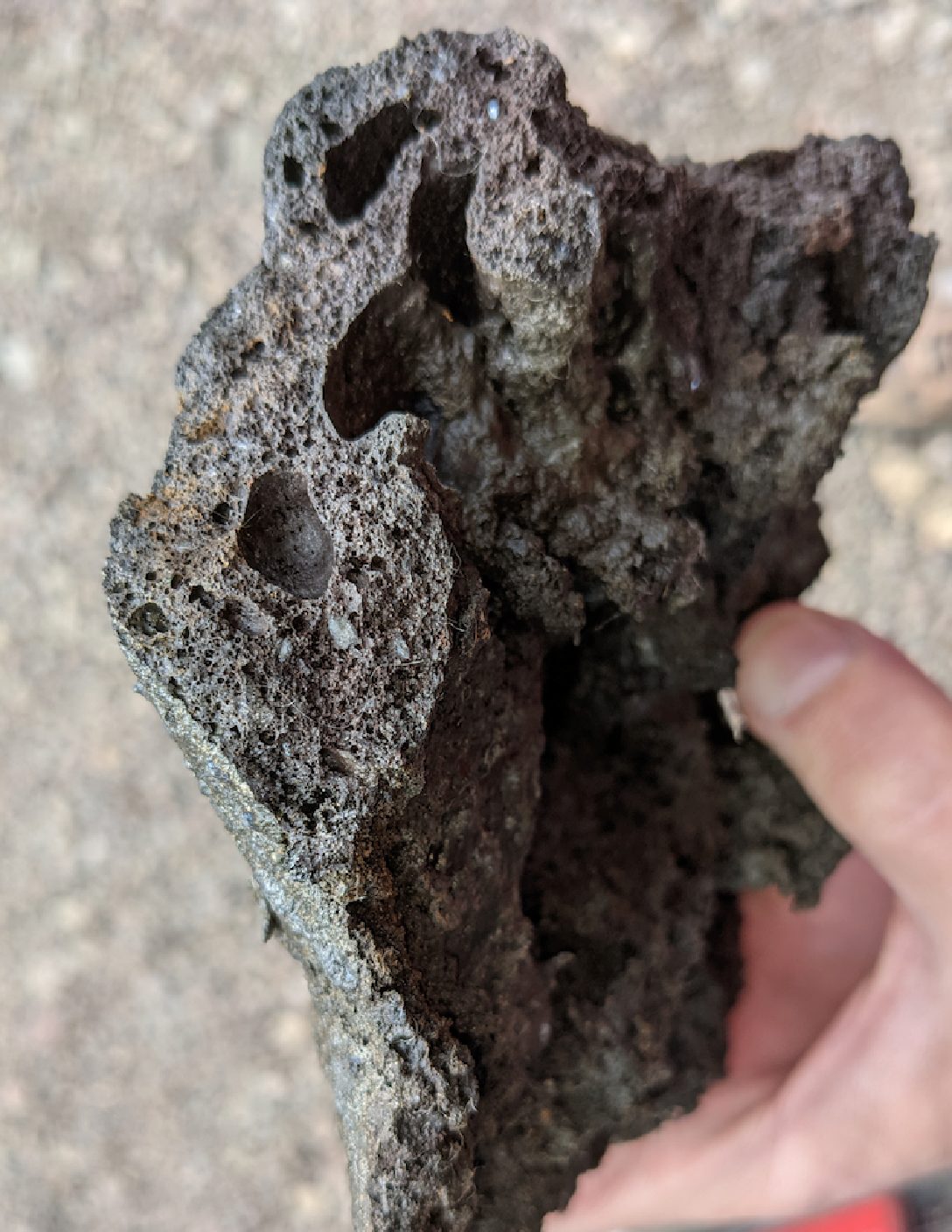Cite as: Benner, S. A. (2022) “Ribonucleic acid is formed by percolating ribonucleoside triphosphates through basalt glass”. Primordial Scoop, e20220526. https://doi.org/10.52400/NQPZ2462
Occasionally on these pages, we discuss recent publications important to life, the universe, and the scientific method. Let me indulge today in a report from my own organization, just appearing on line in the journal Astrobiology [1]. It covers a study led by Elisa Biondi here at the Foundation for Applied Molecular Evolution.
Its principal finding is that ribonucleic acid, which some think was the first genetic material in our Solar System, spontaneously forms on basalt lava glass when a solution of nucleoside triphosphates percolates through them. Such glass was abundant on Earth 4.35 billion years ago.
We know this in part because similar basalts of this antiquity survive on Mars today. Indeed, some Martian basalts were ejected from Mars by impacts there. These rocks traveled through space to Earth, where they are collected (and sold) by people living near the Sahara Desert. Bob Bruner, a citizen scientist in Denver, helped us acquire such a piece of Mars a few years back.
The chemistry described is simple. Ribonucleic molecules, 100-200 nucleotides in length, form when nucleoside triphosphates do nothing more than percolate through basaltic glass. Basaltic glass comes from rapidly congealing basalt lava.
Which glass proved to be important. Basaltic glass is more “mafic”, containing more magnesium and iron. In some ways, basalt is also more “primitive”. Basalt glass works better than andesitic glass, which contains more silicon and aluminum (“sialic”). Pure quartz, silica only, did not work at all.
Elisa did many experiments to confirm this initial observation. Prompted by Jack Szostak and interested others, she considered the possibility that non-covalent aggregation or branching might mislead our estimate of the lengths of the products, which was first done by gel electrophoresis. She did experiments that confirmed the sizes and covalent nature of the ribonucleic acid products by ultrafiltration under many conditions, including in acid, in base, and with organic solvents. Ultrafiltration exploits a different separation principle than gel electrophoresis, and thus provides an independent test of molecular size.
Elisa, with Craig Jerome and Hyo-Joong Kim, then experimented to further confirm the oligomeric ribonucleic acid structure that was assigned to the products. The products were degraded by enzymes that do not efficiently degrade either branched structures nor 2′,5′-links. Degradation at high pH yielded nucleoside 2′- and 3′-monophosphates, here leaving branched links untouched. Recovered by chromatography, their structures were proven by UV spectroscopy and comparison with authentic materials. These products require a structure with predominantly internucleotide unbranched linkages, either 2′,5′ or 3′,5′.
This is a classical chemical structure proof, very much similar to the analysis that proved the structure of natural ribonucleic acid before 1953. Of course, even that proof did not rule out small amounts of branching, which we now know exist in natural RNA. Thus, a small amount of branching, and a significant number of 2′,5′-linkages, cannot be excluded in the products formed on basaltic glass.
We worried about this for a while. But then it occurred to us: The formation on basaltic glass of 100-200 mer ribonucleic acid with some branching is itself not uninteresting, even if we could not determine the ratio of 2′,5′ and 3′,5′ links. Indeed, before Dan Brown’s work in 1953, no one knew the details of those linkages in natural RNA. Further, branched RNA structures exist and are functional in natural RNA to this day.
For several hundred million years after the Moon formed, frequent impacts on Earth coupled with abundant volcanism on the young planet formed molten basaltic lava. This cooled rapidly to give the basalt glass. Impacts also evaporated water to give dry land, providing aquifers where RNA could have formed.
I will next week post a Single Scoop on my trip to Iceland last month. Iceland’s basalt flows offer a more-or-less modern Earth analog of the vitrified basalt relevant to this result. The picture above is from this trip. I also visited a cave on Iceland, perhaps a modern analog of the aquifer environment where all of this chemistry purportedly happened.
The same impacts also delivered nickel, which we had previously shown [2] gives nucleoside triphosphates from nucleosides and activated phosphate, also found in lava glass [8].
Borate (as in borax) controls where those triphosphates get their triphosphate. Borate is scarce on Earth by total mass. However, borate is concentrated in residual basalt melts, from which it weathers. Borate is also found today in large amounts on the surface of Mars [10], evidently appearing by this process. Borate reappears throughout a path to control the regiochemistry of molecular transformations, and to prevent formation of “tars”.
Indeed, that is one of the nice things about the result. Basaltic glass resulting from impactors re-appears again and again in a model that moves from simple one and two carbon species to oligomeric ribonucleic acid [3].
For example, Nils Holm a decade ago noted that “condensed phosphate” may also be provided by lava glasses [8]. Cyclic triphosphate, one of these “condensed” phosphate molecules, appears frequently in the path. For example, the path makes a ribose cyclic phosphate by exploiting some chemistry of inorganic cyclic triphosphate that was developed 20 years ago by Ram Krishnamurthy et al. [9].
As another example, the same impactors that formed the glass also transiently reduced the atmosphere with their metal iron-nickel cores [3]. RNA bases, whose sequences store genetic information, are formed in such atmospheres [5]. We previously showed that nucleosides are formed by a simple reaction between ribose phosphate and the canonical bases [6][7].
Thus, this work adds a degree of completeness to a “discontinuous synthesis” path that we proposed in 2019 to create ribonucleic acid from small organic molecules that were almost certainly present on the early Earth [3]. In a single geological environment, the model moves one and two carbon molecules made in the Hadean atmosphere to give ribonucleic acid molecules long enough to support Darwinian evolution.
One of the nice things about doing science is that after one creates such a model, one next can have the fun of ripping it down. For example, we still do not know how all of the RNA building blocks came to have the same general shape, a relationship known as homochirality that I have discussed elsewhere on this blog. Further, we lacked the financial resources to determine the percentages of 2′,5′ and 3′,5′ linkages in the material synthesized on basaltic glass. We do not know whether these percentages are important. Some think they are, others do not.
Hence, I refer to the products obtained from basaltic glass as “ribonucleic acids”. This deliberately leaves the linkages and a bit of branching ambiguous.
Stay tuned as we do more to attack our model.
In particular, the ultimate test of any discontinuous model is to make it continuous. Only when scientists can, in one system, pour molecules that were indisputably present in the Hadean atmosphere, onto rocks that were indisputably present on the Hadean surface, and observe the formation of RNA, to the point of calculating a ‘yield’ for the process, will the community be convinced that this process might have worked on early Earth. And even then, it is only ‘might‘.
Mars is relevant because the same minerals, glasses, and impacts were also in the history of Mars of that antiquity. However, Mars has not suffered continental drift and plate tectonics that buried most rocks from Earth older than 4 billion years. Thus, rocks from the relevant time remain on the surface of Mars. Recent missions to Mars have found all of the needed rock species, including borate [10]. Thus, if ribonucleic acid emerged on Earth via this simple path, then it also likely emerged on Mars. This makes it even more important to seek life on Mars as soon as we can.
Jan Špaček, who was not involved in this study, but who develops instruments to detect alien genetic polymers on Mars, pointed out that this process is simple enough to be tested by high school students in their chemistry classes. Since high school labs cannot use radioactivity or HPLCs, we need to devise another analytical tool for them to see the RNA.
Stay tuned for that also.
[1] Biondi, E., Jerome, C. A., Kim, H.-J.,Mojzsis, S. J., Benner, S. A. (2022) Catalytic synthesis of polyribonucleic acid on prebiotic rock glasses. Astrobiology [https://www.liebertpub.com/doi/full/10.1089/ast.2022.0027]
[2] Kim, H.J., Benner, S.A. (2021) Abiotic synthesis of nucleoside 5′-triphosphates with nickel borate and cyclic trimetaphosphate (CTMP) Astrobiol. 21, 298-306.
[3] Benner, S. A., Kim, H.-J., Biondi, E. (2019) Prebiotic chemistry that could not not have happened. Life 9(4), 84.
[4] Kawai, J., McLendon, D. C., Kim, H. J., Benner, S. A. (2019) Hydroxymethanesulfonate from volcanic sulfur dioxide. A mineral reservoir for formaldehyde in prebiotic chemistry. Astrobiol. 19, 506-516.
[5] Benner, S. A., Bell, E. A., Biondi, E., Brasser, R., Carell, T., Kim, H.-J., Mojzsis, S. J., Omran, A., Pasek, M. A., Trail, D. (2019) When did life likely emerge on Earth in an RNA-first process? ChemSystChem 1:e190003
[6] Kim, H. J., Benner, S. A. (2017). Prebiotic stereoselective synthesis of purine and noncanonical pyrimidine nucleotide from nucleobases and phosphorylated carbohydrates. Proc. Natl. Acad. Sci. USA 114, 11315-11320. PMC5664531. doi: 10.1073/pnas.1710778114
[7] Kim, H. J., Kim, J. (2019). A prebiotic synthesis of canonical pyrimidine and purine ribonucleotides. Astrobiology, 19(5), 669-674.
[8] Holm, N. G. (2014) Glasses as sources of condensed phosphates on the early earth. Geochem. Trans. 15, 1-4.
[9] Krishnamurthy, R., Guntha, S., Eschenmoser, A. (2000) Regioselective a-phosphorylation of aldoses in aqueous solution. Angew. Chem. 39, 2281-2285.
[10] Gasda, P. J., Haldeman, E. B., Wiens, R. C., Rapin, W., Bristow, T. F., Bridges, J. C., … McInroy, R. (2017) In situ detection of boron by ChemCam on Mars. Geophys. Res. Lett, 44, 8739-8748.




Nanopore sequencing might work and is easy to use. Only non-branched RNA would be scanned.